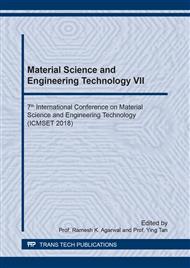p.85
p.90
p.97
p.103
p.110
p.117
p.123
p.128
p.133
In Situ Rapid Dechlorination by Microwave-Assisted Catalytic Reduction of Chlorobenzene and 1,4-Dichlorobenzene on Raney Ni-Al Alloy Catalyst
Abstract:
Microwave-assisted catalytic reductive dechlorination on Raney Ni-Al alloy catalyst is an efficient method for treatment of chlorobenzene (CB) and 1,4-dichlorobenzene (1,4-DCB). The result shows that the Raney Ni-Al alloy catalyst retains its high activity in this in-situ reductive dechlorination reaction. The reductive dechlorination reaction was in accordance of a psendo-second-order reaction kinetics under the microwave irradiation. The apparent reductive reaction rate constant of CB dechlorination was 0.0175 L/mol·min at 30°C and 0.114 L/ mol·min at 50°C, and the activation energy Ea was 76.24 kJ/mol. The reaction rate constant of 1,4-DCB dechlorination was 0.0376 L/ mol·min at 35 °C and 0.151 L/ mol·min at 50 °C, and the activation energy Ea was 76.66 kJ/mol. The dechlorination for CB and 1,4-DCB was rapid and complete under mild conditions. It shows that the microwave-assisted catalytic in-situ reductive dechlorination on Raney Ni-Al alloy catalyst is an effective method for dechlorination of polychlorinated organic compounds.
Info:
Periodical:
Pages:
110-116
Citation:
Online since:
April 2019
Authors:
Price:
Сopyright:
© 2019 Trans Tech Publications Ltd. All Rights Reserved
Share:
Citation:


